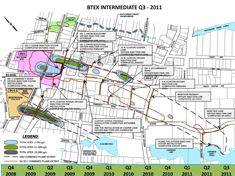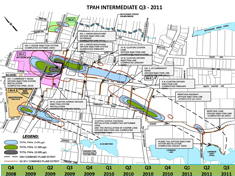OU-2 Cleanup Progress
The OU-2 groundwater plume consists of contaminated water which had already migrated southward from OU-1 prior to the remediation of the OU-1 source areas several years ago. This water moves very slowly through the subsurface. Without additional cleanup efforts, it would take several decades for natural groundwater flow to flush contaminants out of the aquifer beneath this predominantly residential area.
To date, National Grid has installed eight oxygen injection systems to treat groundwater in OU-2. The purpose of this system is to increase the amount of oxygen dissolved in the groundwater throughout the OU-2 area, allowing naturally-occurring soil bacteria to consume the contaminants in place, rather than waiting for the flushing process to be completed.
The oxygen injection systems within OU-2 continue to operate as designed. NYSDEC and National Grid continue to monitor their effectiveness.
Groundwater contamination in OU-2 has responded very well to the oxygen injection treatment. Figure 1 compares the original extent of the groundwater contaminant plume to the current extent, and demonstrates that the plume has been sharply reduced. In particular, contamination in shallow groundwater (the water closest to the ground surface, which presents the highest possibility for human exposure) has been reduced to levels which meet drinking water standards, with the exception of a small area near the corner of Union Boulevard and North Clinton Avenue.
Significant reductions are also evident in the intermediate zone in recent sampling events. As discussed above, modifications to the existing systems to target the remaining groundwater impacts in this area were implemented in June-July 2015. As a result of the groundwater concentration reductions, two of the eight oxygen injection systems in OU-2 have been deactivated in accordance with the Site’s remediation system shutdown criteria. The two deactivated systems are the short oxygen line located just north of Community Road half way between Cooper Lane and Montauk Highway, and the system that runs along Lawrence Creek.
Pockets of contaminated groundwater remain in the rest of OU-2 at depths of 13 to 60 feet below the ground surface. These pockets are responding more slowly to treatment, but they are responding. Modifications to several of the oxygen injection systems were made in late 2013 to target these lingering impacts.



